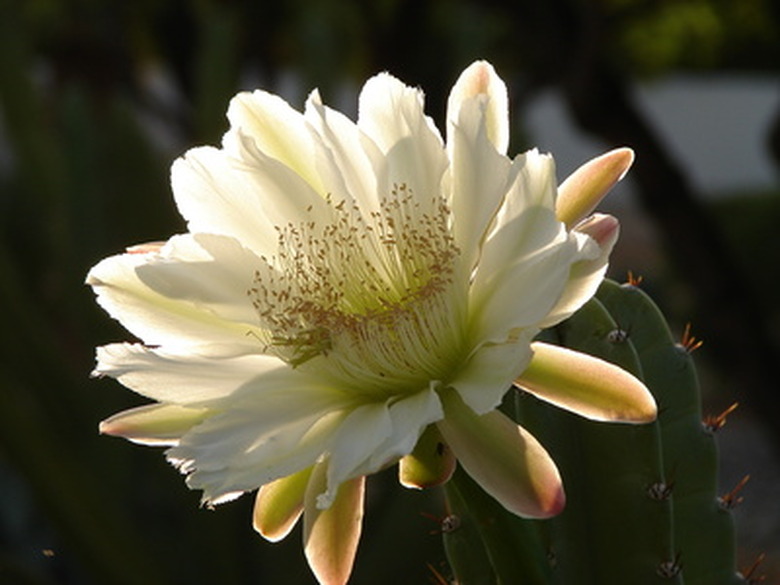How To Grow Night Blooming Cereus Cuttings
Native to Central and South American rain forests, night-blooming cereus (Epiphyllum oxypetalum) is a climbing cactus sans the thorns. In maturity, it blooms in seven-inch, highly fragrant flowers, bi-weekly, from mid-summer to fall, from midnight until dawn, for one day only. If pollinated during this period, the plant will produce red berries after blooming. Night-blooming cereus can be grown outdoors, in the landscape, in the warmer regions of the U.S. Fortunately for northern gardeners, it thrives in pots as well. Take the cutting after the plant has finished blooming.
Step 1
Use a sharp knife to cut a four- to six-inch length of stem off the night blooming cereus. Cut at a node, which is an area that looks like a joint.
- Native to Central and South American rain forests, night-blooming cereus (Epiphyllum oxypetalum) is a climbing cactus sans the thorns.
Step 2
Allow the cutting to sit in a dry area for two days.
Step 3
Fill a planting pot with dry sand. Use your finger to create a planting hole for the cutting.
Step 4
Dip the cut end of the night blooming cereus cutting into the rooting hormone and then stick it in the prepared planting hole.
Step 5
Water the night blooming cereus cutting two days after planting by misting the soil with water from the misting bottle until it is barely moist.
Step 6
Place the pot in a shady area until the night blooming cereus has rooted. You will know this has occurred when a gentle tug on it meets with resistance. Place the cutting in filtered sunlight and water it until the water drains from the bottom of the pot.
- Allow the cutting to sit in a dry area for two days.
- Place the cutting in filtered sunlight and water it until the water drains from the bottom of the pot.
Care Of Night Blooming Cereus
Four different plants are commonly referred to as night-blooming cereus. These include dragon fruit (Hylocereus undatus), also sometimes referred to as pitaya or strawberry pear, and Dutchman's Pipe (Epiphyllum oxypetalum). If you grow yours outdoors, make sure to plant it in a spot where intense exposure to sunlight and heat is unlikely. In fact, too much shade can inhibit flowering and cause poor fruit production, which is important if you're interested in harvesting dragon fruit. Night-blooming cereus tolerate cool climates but can be damaged by colder temperatures. They like well-draining, sandy soil best with compost added for nutrients. However, unlike those planted in the ground, potted night-blooming cereus could take from three to five years to produce flowers. Because of the cold sensitivity of night-blooming cereus, bring your potted plant inside whenever there is a cold snap.
- Four different plants are commonly referred to as night-blooming cereus.
- However, unlike those planted in the ground, potted night-blooming cereus could take from three to five years to produce flowers.
Things Needed
- Knife
- Planting pot
- Sand
- Rooting hormone
References
- Cornell University: Night-Blooming Cereus
- Bella Online: Night-Blooming Cereus
- Texas A&M University: Cactus Family
- Arizona-Sonora Desert Museum: Plant Care Information: Desert Night-blooming Cereus or Saramatraca Peniocereus greggii
- Urban Harvest: Dragon Fruit
- Plants for a Future: Hylocereus undatus – (Haw.) Britton & Rose
- Arizona-Sonora Desert Museum: Peniocereus greggii (Engelmann) Britton & Rose 1909
- University of Arizona Campus Arboretum: Peniocereus greggii
- The University of Arizona College of Agriculture and Life Sciences:
- Sonoran Desert Florilegium Program: The Cactaceae N.L. Britton and J.N. Rose
- University of Florida IFAS Blogs: Q: What Can You Tell Me About Night Blooming Cactus?
- University of Arkansas Division of Agriculture Research and Extension: Cooperative Extension Service: Night Blooming Cereus
- Mead Botanical Garden: Night-Blooming Cereus
